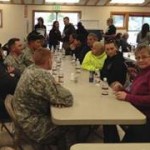CHICAGO –Beginning Tuesday, August 26, the Michigan State Police, Emergency Management and Homeland Security Division (MSP/EMHSD), FEMA, U.S. Small Business Administration (SBA) and local officials in the Metro Detroit area will be conducting joint preliminary damage assessments due to the flooding that occurred the week of August 11.
Six teams will be canvassing Macomb, Oakland and Wayne counties to assess and validate damages and disaster impacts against federal assistance eligibility criteria. MSP/EMHSD, FEMA and SBA team members will be wearing shirts with agency names and logos prominently displayed. Personnel will also have their credentials visible.
When considering eligibility for federal individual assistance—or assistance for homeowners, renters and business owners—damage assessment teams consider a number of factors:
- Size and scope of damage as well as threat to public safety. Assessment teams are tasked to collect a description and extent of damages and the impact on individuals in the affected areas. To do so, they will try to talk to as many local officials, renters, homeowners and business owners as possible, taking note of details such as water depth, structural integrity of buildings, damage to mechanical components (i.e. furnace, water heater, HVAC, etc.), insurance coverage in place, length of time floodwater has been in a home, and materials used to build the dwelling. It is not necessary for the teams to visit every home in order to complete the assessment.
- Number of primary homes requiring extensive repairs or with structural damage. When collecting this data, teams are looking for failure of major structural components in a building and floodwater depths of more than 18 inches in areas of a residence that meet the federal definition of essential living space.
- It’s important to note: if a presidential declaration for individual assistance is made:
- Floodwater or sewer backup damages in recreational rooms, unoccupied basements or storage spaces generally do not qualify for FEMA assistance programs. However, disaster-related damages to a home’s mechanical components or those in areas of a residence that meet the federal definition of essential living space—regardless of the location in the home—may be considered eligible for federal assistance.
- Federal grant funding is made available to eligible applicants as a supplement to local and state resources and insurance payments to help survivors return to safe, sanitary and functional housing. It is not meant to return a home and its contents to pre-disaster conditions.
- It’s important to note: if a presidential declaration for individual assistance is made:
- Duplication of benefits. By law, FEMA cannot duplicate benefits—such as those from insurance, local housing authorities, the Department of Housing and Urban Development and the Department of Veterans Affairs. If approved, FEMA individual assistance is always supplemental to that assistance.
- Number and length of time people are displaced. This information may include number of homes that are not habitable. Teams also attempt to determine whether the community has adequate housing resources to meet the needs of displaced survivors for the time it takes to repair their home.
- Ability of the community to recover. Since disasters affect communities differently, teams will collect and document specific characteristics of each—such as demographic and economic data—that may impact their ability to recover. In addition, it is important for the teams to document critical infrastructure that may be unavailable for an extended period of time—i.e. hospitals, schools, utilities and nursing homes—as this could also significantly affect a community’s ability to recover.
- Voluntary agency/state program assistance available. Local non-profit, faith-based and community-based organizations contribute substantially to response and recovery after a disaster. Along with local and state governments, these organizations often help survivors immediately after an emergency and, in some cases, have the capability and resources to meet the recovery needs of the affected areas. During the damage assessment, teams document whether, and to what extent, these organizations may be able to meet the essential needs of survivors.
- Extent of the business losses. The Small Business Administration (SBA) is part of the team and assesses damage to businesses in affected communities. In the event of a federal declaration, the SBA can make low interest loans available to assist businesses as well as homeowners and renters with their recovery costs. FEMA also considers whether the loss of critical businesses like grocery stores, gas stations, or stores that sell building materials and supplies in affected communities could impact recovery.
Once the damage assessments are complete, state officials use the damage totals and impact data to determine whether the disaster meets established criteria and can warrant the governor requesting a federal declaration and assistance.
To find more information about FEMA’s declaration process or disaster assistance programs, visit www.FEMA.gov or www.disasterassistance.gov.
FEMA’s mission is to support our citizens and first responders to ensure that as a nation we work together to build, sustain, and improve our capability to prepare for, protect against, respond to, recover from, and mitigate all hazards. Follow FEMA online at twitter.com/femaregion5, www.facebook.com/fema, and www.youtube.com/fema. Also, follow Administrator Craig Fugate’s activities at twitter.com/craigatfema. The social media links provided are for reference only. FEMA does not endorse any non-government websites, companies or applications.
FEMA Media Contact: Sandy Jasmund, 312-213-5291
Michigan MSP/EMHSD Media Contact: Ron Leix, 517-336-6464
###
Read article here:




